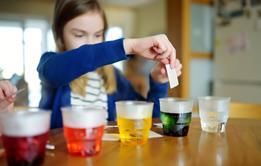Learn how to make fizzing bath bombs by mixing an acid and an alkali
Did you know you can make bath bombs using ingredients you can find in your kitchen?
In this video, RSC education coordinator Catherine shows how to make fun fizzing bath bombs by making a mixture of an acid and an alkali, explaining the reaction when they are dropped into a bath. This simple activity can be set for learners to try at home with a responsible adult or used as a classroom experiment.
Equipment list
- Two bowls
- A tablespoon
- Ice cube tray, or something to shape the bath bombs
- Bicarbonate of soda
- Citric acid powder or cream of tartar
- A small amount of water
- Food colouring (optional)
- Essential oils (optional)
Health and safety
- Make sure that you thoroughly clean any equipment before using for food.
- Consider any possible allergies before undertaking the experiment.
Activity instructions
- In one bowl, mix together two tablespoons of bicarbonate of soda with one tablespoon of citric acid or cream of tartar.
- In the other bowl, mix together a tablespoon of water and 3-4 drops of food colouring and essential oils (this step is optional).
- Tip the dry ingredients into the bowl with the wet ingredients and thoroughly mix together until combined. The result may still be a little crumbly but will stick together when pressed.
- Shape the mixture into the mould you’re using and press down firmly to ensure the mixture sticks together. These quantities will make two small bath bombs.
- Leave overnight, then the bath bombs can be eased out of the mould and placed into a tub or bath of water to watch the reaction.
Explanation
When an acid and an alkali react together, a gas is produced. This can be demonstrated by combining an acid and an alkali and observing that there is no reaction while the ingredients are dry. However, when dropped into water the bath bomb dissolves and a chemical reaction occurs and a gas can be seen fizzing from the bath bomb – in this case the gas is carbon dioxide. This experiment also shows how materials change and is an example of a non-reversible reaction.
Also check out
- More simple experiments using everyday equipment which your learners can try at home or you can bring to the classroom on our YouTube playlist.
- Read the CLEAPSS guidance on practical activities for pupils at home during extended periods of school closure, GL339.
- Read the SSERC guidance for primary home learning.
Downloads
Making bath bombs teacher notes
Handout | PDF, Size 0.13 mbMaking bath bombs teacher notes
Editable handout | Word, Size 90.47 kbMaking bath bombs handout
Handout | PDF, Size 71.73 kb
From kitchen to classroom

Simple chemistry experiments using kitchen cupboard equipment. Use in the classroom or set as an activity for learners to do at home with a responsible adult.
































1 Reader's comment